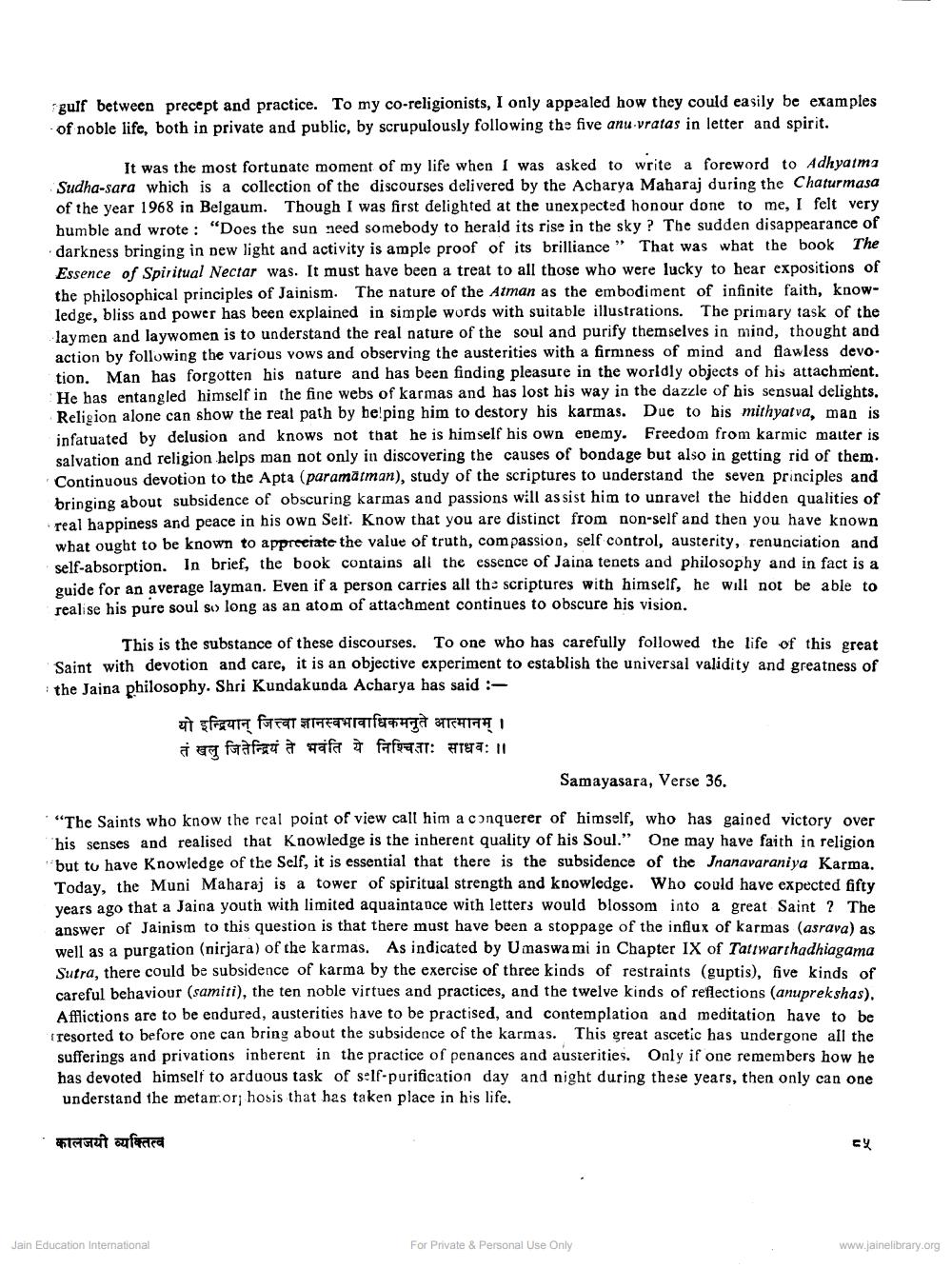________________
gulf between precept and practice. To my co-religionists, I only appealed how they could easily be examples of noble life, both in private and public, by scrupulously following the five anu vratas in letter and spirit.
It was the most fortunate moment of my life when I was asked to write a foreword to Adhyatma Sudha-sara which is a collection of the discourses delivered by the Acharya Maharaj during the Chaturmasa of the year 1968 in Belgaum. Though I was first delighted at the unexpected honour done to me, I felt very humble and wrote: “Does the sun need somebody to herald its rise in the sky ? The sudden disappearance of darkness bringing in new light and activity is ample proof of its brilliance " That was what the book The Essence of Spiritual Nectar was. It must have been a treat to all those who were lucky to hear expositions of the philosophical principles of Jainism. The nature of the Atman as the embodiment of infinite faith, knowledge, bliss and power has been explained in simple words with suitable illustrations. The primary task of the laymen and laywomen is to understand the real nature of the soul and purify themselves in mind, thought and action by following the various vows and observing the austerities with a firmness of mind and flawless devotion. Man has forgotten his nature and has been finding pleasure in the worldly objects of his attachment. He has entangled himself in the fine webs of karmas and has lost his way in the dazzle of his sensual delights. Religion alone can show the real path by helping him to destory bis karmas. Due to his mithyatva, man is infatuated by delusion and knows not that he is himself his own enemy. Freedom from karmic matter is salvation and religion helps man not only in discovering the causes of bondage but also in getting rid of them. Continuous devotion to the Apta (paramaman), study of the scriptures to understand the seven principles and bringing about subsidence of obscuring karmas and passions will assist him to unravel the hidden qualities of real happiness and peace in his own Self. Know that you are distinct from non-self and then you have known what ought to be known to appreciate the value of truth, compassion, self control, austerity, renunciation and self-absorption. In brief, the book contains all the essence of Jaina tenets and philosophy and in fact is a guide for an average layman. Even if a person carries all the scriptures with himself, he will not be able to realise his pure soul so long as an atom of attachment continues to obscure his vision.
This is the substance of these discourses. To one who has carefully followed the life of this great Saint with devotion and care, it is an objective experiment to establish the universal validity and greatness of the Jaina philosophy. Shri Kundakunda Acharya has said :
यो इन्द्रियान् जित्त्वा ज्ञानस्वभावाधिकमनुते आत्मानम् । तं खलु जितेन्द्रियं ते भवंति ये निश्चिताः साधवः ।।
Samayasara, Verse 36.
“The Saints who know the real point of view call him a conquerer of himself, who has gained victory over his senses and realised that Knowledge is the inherent quality of his Soul." One may have faith in religion but to have knowledge of the Self, it is essential that there is the subsidence of the Jnanavaraniya Karma. Today, the Muni Maharaj is a tower of spiritual strength and knowledge. Who could have expected fifty years ago that a Jaina youth with limited aquaintance with letters would blossom into a great Saint ? The answer of Jainism to this question is that there must have been a stoppage of the influx of karmas (asrava) as well as a purgation (nirjara) of the karmas. As indicated by Umaswami in Chapter IX of Tatrwarthadhiagama Sutra, there could be subsidence of karma by the exercise of three kinds of restraints (guptis), five kinds of careful behaviour (samiti), the ten noble virtues and practices, and the twelve kinds of reflections (anuprekshas). A Mictions are to be endured, austerities have to be practised, and contemplation and meditation have to be i resorted to before one can bring about the subsidence of the karmas. This great ascetic has undergone all the sufferings and privations inherent in the practice of penances and austerities. Only if one remembers how he has devoted himself to arduous task of self-purification day and night during these years, then only can one understand the metar.or; hosis that has taken place in his life.
- कालजयी व्यक्तित्व
EY
Jain Education International
For Private & Personal Use Only
www.jainelibrary.org




